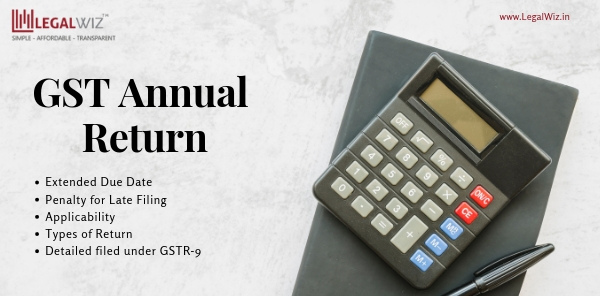Annual filing is must compliance for most businesses, so it is under GST law. Every person registered under GST is required to file Annual Return under GST law subject to applicability. Released in September, the GST Annual Return was due by 31st March, 2018. Facing many requests for extension, the compliance date is extended for 3 months by CBIC through a press release dated 7th December. (Official notification yet to be released)
If you are yet unfamiliar with GSTR 9, let’s dig into the requirements of GSTR 9 filing, an upcoming compliance for all.

Page Contents
What is GSTR 9 or GST Annual Return?
GST Annual return is filed by a GST registered person, once in a year. It is applicable to every registrant, even if registered under Composition Scheme. The reporting period for the form is the whole financial year.
At present, the concerned reporting period is F.Y. 2017-18. Having it the first Annual Compliance after implementation of GST, the taxpayers have faced many ambiguities for concerns including the provided format and details sought.
Therefore the many taxpayers and stakeholders including the Karnataka CA association have sought an extension for the compliance. Let’s see the due date for filing GST 9.
Due Date for filing GST Annual Return:
The taxpayers are required to file GST Annual Return latest by 31st December of the next Financial Year.
For the last Financial Year 2017-18, the due date was 31st December, 2018. The due date for filing GSTR 9, GSTR 9A and GSTR 9C is duly extended for 3 months, till 31st March, 2019.
Due to various ambiguities in the utility model, the said extension was quite expected. The online utility for filing is not available even today. Further, even the large taxpayers are finding difficulties to understand many nuances. However, the extension should not be a reason for you to be compliance ready.
Upon failure to comply, you are required to pay penalty on daily basis. Therefore, connect with LegalWiz.in experts to be compliance ready. Write to us at support@legalwiz.in to request a call back for personalised assistance.
Penalty for late filing of GST Annual Return:
Penalty is payable under respective tax head on daily basis. For filing the return after the due date, the late fee is INR 100 per day per act. Here, a ceiling limit for the total fee is provided which is an amount calculated at 0.25% of the turnover in the State or UT. Hence, the late fee is INR 100 under CGST and INR 100 under SGST, summing INR 200 for per day of default. Under IGST, there no late fee provided. You should take note that compliance is one of the determinants of GST compliance rating. To maintain the ratings, it is likely to file the return at the earliest instead of waiting for due dates.
Who does not require filing GSTR-9?
The taxpayers falling under the following list are not required to file the Annual return under GST:
- A person registered as Casual Taxable Person
- Input service distributors
- Non-resident taxable persons
- Persons paying TDS under section 51 of GST Act
Types of GST Annual Return:
There are four types of Annual Return forms prescribed for filing by different category of taxpayers.
1. GSTR 9: This form is filed by the regular taxpayers who are filing GSTR 1, GSTR 2 and GSTR 3.
2. GSTR 9A: If you have opted for composition scheme, you are required to file GSTR 9A as an annual return.
3. GSTR 9B: If you are an e-commerce operator and have filed GSTR 8 during the financial year, you are required for file GSTR 9B.
4. GSTR 9C: This form is applicable if your annual turnover exceeds INR 2 crores during the financial year. GSTR 9C is filed in along with the annual return in above-mentioned form. Here, the requirement of GST audit is also levied. Therefore, a copy of audited annual accounts is filed. Additionally, reconciliation statement of already paid tax and tax payable as per audited accounts is filed.
Details filed under GSTR-9:
It requires the registrants to provide the details of supplies made and received during the reporting year. The taxes of all heads i.e. CGST, SGST and IGST are reported with consolidated data of all returns filed during the year. (Monthly/ quarterly)The details are filled in respective GSTR 9 format. The return is typically divided into 6 parts as provided below.
| Part | Required Details |
| I | Part I is typically auto-populated. It requires the details of the taxpayer. |
| II | In this part, details of inward and outward supplies during the FY are provided. This detail must be picked up by consolidating summary from all GST returns filed during the FY. |
| III | It requires details of ITC declared. It is summarised values from all the GST returns filed during the F.Y. |
| IV | It requires the details declared for taxes paid during the F.Y. This section also includes details of cess, interest, late fees, etc. |
| V | This section requires Particulars of the transactions for the previous FY declared in returns of April to September of current FY (2018-19) or up to the date of filing of annual returns of previous FY whichever is earlier. |
| VI | Part VI contains other information. This section comprises details of
Information on supplied received from different categories of taxpayers. |
Filing GST return with the help of professional is quite hassle-free for the businesses. The professionals help to fulfil the compliance removing the burden on your shoulder. The GST return filing services are handled by Chartered Accountant with personalised assistance to taxpayers. For more information, connect with us on support@legalwiz.in.






Sir
when i filed gstr 9 i chhose do you want to file nil return no while chhosing yes because i want to file nil return but now it hide yes what i do please tell me
Sir,
I have GST,Monthly not filled,since, no business .is it possible to file year end ( if only an Purshase
To help through my Email
Regarding the part IV of GSTR9 to provide details of taxes paid during the financial year:
(i) Do I presume this is the total taxes paid including the payment adjusted against ITC
(ii) By taxes paid during the financial year; I presume it is ‘for the financial year’, i.e. the taxes paid in April for the March month of financial year are to be considered.
HELP SUBMIT OF GST R 3 RETRUN DETAILS OF PROCEDURE OF REQUIRE HOW TO SUBMIT THRO PORTAL REQUEST